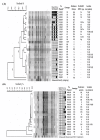Clonal dissemination of the multi-drug resistant Salmonella enterica serovar Braenderup, but not the serovar Bareilly, of prevalent serogroup C1 Salmonella from Taiwan
- PMID: 20017951
- PMCID: PMC2806260
- DOI: 10.1186/1471-2180-9-264
Clonal dissemination of the multi-drug resistant Salmonella enterica serovar Braenderup, but not the serovar Bareilly, of prevalent serogroup C1 Salmonella from Taiwan
Abstract
Background: Nontyphoidal Salmonella is the main cause of human salmonellosis. In order to study the prevalent serogroups and serovars of clinical isolates in Taiwan, 8931 Salmonellae isolates were collected from 19 medical centers and district hospitals throughout the country from 2004 to 2007. The pulsed-field eletrophoresis types (PFGE) and antibiotic resistance profiles of Salmonella enterica serovars Bareilly (S. Bareilly) and Braenderup (S. Braenderup) were compared, and multi-drug resistance (MDR) plasmids were characterized.
Results: Over 95% of human salmonellosis in Taiwan was caused by five Salmonella serogroups: B, C1, C2-C3, D1, and E1. S. Typhymurium, S. Enteritidis, S. Stanley and S. Newport were the four most prevalent serovars, accounting for about 64% of isolates. While only one or two major serovars from four of the most prevalent serogroups were represented, four predominant serovars were found in serogroup C1 Salmonellae. The prevalence was decreasing for S. Choleraeuis and S. Braenderup, and S. Virchow and increasing for S. Bareilly. S. Braenderup mainly caused gastroenteritis in children; in contrast, S. Bareiley infected children and elderly people. Both serovars differed by XbaI-PFGE patterns. Almost all S. Bareilly isolates were susceptible to antibiotics of interest, while all lacked plasmids and belonged to one clone. Two distinct major clones in S. Braenderup were cluster A, mainly including MDR isolates with large MDR plasmid from North Taiwan, and cluster B, mainly containing susceptible isolates without R plasmid from South Taiwan. In cluster A, there were two types of conjugative R plasmids with sizes ranging from 75 to 130 kb. Type 1 plasmids consisted of replicons F1A/F1B, blaTEM, IS26, and a class 1 integron with the genes dfrA12-orfF-aadA2-qacEDelta1-sulI. Type 2 plasmids belonged to incompatibility group IncI, contained tnpA-blaCMY-2-blc-sugE genetic structures and lacked both IS26 and class 1 integrons. Although type 2 plasmids showed higher conjugation capability, type 1 plasmids were the predominant plasmid.
Conclusions: Serogroups B, C1, C2-C3, D1, and E1 of Salmonella caused over 95% of human salmonellosis. Two prevalent serovars within serogroup C1, S. Bareilly and cluster B of S. Braenderup, were clonal and drug-susceptible. However, cluster A of S. Braenderup was MDR and probably derived from susceptible isolates by acquiring one of two distinct conjugative R plasmids.
Figures



Similar articles
-
Serovar distribution, antimicrobial resistance profiles, and PFGE typing of Salmonella enterica strains isolated from 2007-2012 in Guangdong, China.BMC Infect Dis. 2014 Jun 17;14:338. doi: 10.1186/1471-2334-14-338. BMC Infect Dis. 2014. PMID: 24939394 Free PMC article.
-
Multidrug-resistant Salmonella enterica serovar Muenchen from pigs and humans and potential interserovar transfer of antimicrobial resistance.Antimicrob Agents Chemother. 2005 Feb;49(2):503-11. doi: 10.1128/AAC.49.2.503-511.2005. Antimicrob Agents Chemother. 2005. PMID: 15673725 Free PMC article.
-
Detection of multidrug-resistant Salmonella enterica serovar typhimurium phage types DT102, DT104, and U302 by multiplex PCR.J Clin Microbiol. 2006 Jul;44(7):2354-8. doi: 10.1128/JCM.00171-06. J Clin Microbiol. 2006. PMID: 16825349 Free PMC article.
-
Prevalence and distribution of non-typhoidal Salmonella enterica serogroups and serovars isolated from normally sterile sites: A global systematic review.Epidemiol Infect. 2023 Oct 18;152:e4. doi: 10.1017/S0950268823001693. Epidemiol Infect. 2023. PMID: 37850326 Free PMC article.
-
Salmonella serovars from foodborne and waterborne diseases in Korea, 1998-2007: total isolates decreasing versus rare serovars emerging.J Korean Med Sci. 2010 Dec;25(12):1693-9. doi: 10.3346/jkms.2010.25.12.1693. Epub 2010 Nov 24. J Korean Med Sci. 2010. PMID: 21165281 Free PMC article. Review.
Cited by
-
Invasive Salmonellosis by the Very Rare Salmonella choleraesuis in a Returning Traveler on a Tumor Necrosis Factor- α Inhibitor.Case Rep Med. 2014;2014:934657. doi: 10.1155/2014/934657. Epub 2014 Feb 23. Case Rep Med. 2014. PMID: 24715927 Free PMC article.
-
Prevalence and Distribution of Salmonella in Water Bodies in South America: A Systematic Review.Microorganisms. 2025 Feb 22;13(3):489. doi: 10.3390/microorganisms13030489. Microorganisms. 2025. PMID: 40142382 Free PMC article. Review.
-
Salmonella Serogroup C: Current Status of Vaccines and Why They Are Needed.Clin Vaccine Immunol. 2016 Sep 6;23(9):737-45. doi: 10.1128/CVI.00243-16. Print 2016 Sep. Clin Vaccine Immunol. 2016. PMID: 27413069 Free PMC article. Review.
-
A cross-border outbreak of Salmonella Bareilly cases confirmed by whole genome sequencing, Czech Republic and Slovakia, 2017 to 2018.Euro Surveill. 2021 Apr;26(14):2000131. doi: 10.2807/1560-7917.ES.2021.26.14.2000131. Euro Surveill. 2021. PMID: 33834963 Free PMC article.
-
Emergence of Multidrug-Resistant Salmonella enterica Serovar Goldcoast Strains in Taiwan and International Spread of the ST358 Clone.Antimicrob Agents Chemother. 2019 Sep 23;63(10):e01122-19. doi: 10.1128/AAC.01122-19. Print 2019 Oct. Antimicrob Agents Chemother. 2019. PMID: 31383653 Free PMC article.
References
-
- Aarestrup FM, Hendriksen RS, Lockett J, Gay K, Teates K, McDermott PF, White DG, Hasman H, Sorensen G, Bangtrakulnonth A, Pornreongwong S, Pulsrikarn C, Angulo FJ, Gerner-Smidt P. International spread of multidrug-resistant Salmonella Schwarzengrund in food products. Emerg Infect Dis. 2007;13:726–731. - PMC - PubMed
-
- Chang CC, Lin YH, Chang CF, Yeh KS, Chiu CH, Chu C, Chien MS, Hsu YM, Tsai LS, Chiou CS. Epidemiologic relationship between fluoroquinolone-resistant Salmonella enterica Serovar Choleraesuis strains isolated from humans and pigs in Taiwan (1997 to 2002) J Clin Microbiol. 2005;43:2798–2804. doi: 10.1128/JCM.43.6.2798-2804.2005. - DOI - PMC - PubMed
Publication types
MeSH terms
LinkOut - more resources
Full Text Sources
Medical
Miscellaneous

